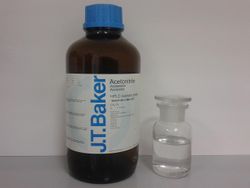Acetonitrile
 Acetonitrile sample and its original bottle.
| |
| Names | |
|---|---|
| IUPAC name
Acetonitrile
| |
| Systematic IUPAC name
Acetonitrile | |
| Other names
Cyanomethane
Ethanenitrile Ethyl nitrile Methanecarbonitrile Methyl cyanide | |
| Identifiers | |
| Jmol-3D images | Image |
| |
| Properties | |
| C2H3N CH3CN | |
| Molar mass | 41.05 g/mol |
| Appearance | Colorless liquid |
| Density | 0.786 g/mL |
| Melting point | −46 to −44 °C (−51 to −47 °F; 227 to 229 K) |
| Boiling point | 81.3 to 82.1 °C (178.3 to 179.8 °F; 354.4 to 355.2 K) |
| Miscible | |
| Solubility | Miscible with acetone, ethanol, methyl ethyl ketone, toluene, xylene |
| Vapor pressure | 9.71 kPa (at 20.0 °C) |
| Thermochemistry | |
| Std molar
entropy (S |
149.62 J·K−1·mol−1 |
| Std enthalpy of
formation (ΔfH |
40.16–40.96 kJ·mol−1 |
| Hazards | |
| Safety data sheet | ScienceLab |
| Flash point | 2.0 °C |
| Lethal dose or concentration (LD, LC): | |
| LD50 (Median dose)
|
2 g/kg (dermal, rabbit) 2.46 g/kg (oral, rat) |
| LC50 (Median concentration)
|
5655 ppm (guinea pig, 4 hr) 2828 ppm (rabbit, 4 hr) 53,000 ppm (rat, 30 min) 7500 ppm (rat, 8 hr) 2693 ppm (mouse, 1 hr) |
| Related compounds | |
| Related compounds
|
Hydrogen cyanide |
| Except where otherwise noted, data are given for materials in their standard state (at 25 °C [77 °F], 100 kPa). | |
| Infobox references | |
Acetonitrile, also known as cyanomethane, ethanenitrile or methyl cyanide is a organic chemical compound, mainly used as a solvent in chemistry. It has the formula CH3CN.
Contents
Properties
Chemical
Acetonitrile reacts with aldehydes to form hydroxynitriles.
- R-CHO + CH3CN → R-CH(OH)-CH2(CN)[1]
Palladium chloride will form a complex with acetonitrile:
- PdCl2 + 2 CH3CN → PdCl2[CH3CN]2
Pyrolysis of acetonitrile yields carbon dioxide, water and hydrogen cyanide.
Physical
Acetonitrile is a colorless liquid, with a faint ether-like or sweet-burnt smell. Acetonitile is hygroscopic, and will readily absorb water from air if kept in open air over time. It has a melting point between −46 to −44 °C and a boiling point between 81.3 to 82.1 °C.
Availability
Acetonitrile can be purchased from chemical suppliers. ScienceStuff sells 1 liter at $76.88 + UPS hazardous material surcharge of $28.50 per shipment. In most places it's difficult to acquire due to being a cyanide compound.
Preparation
Acetonitrile can be made by dehydrating acetamide, which itself results from the thermal decomposition of ammonium acetate.
- CH3COONH4 → CH3C(O)NH2 + H2O
- CH3C(O)NH2 → CH3CN + H2O
Projects
- Ethylamine synthesis
Handling
Safety
Acetonitrile has modest toxicity in small doses, but it will be metabolised by the organism to produce hydrogen cyanide, which is very toxic. This occurs several hours after the exposure. Acetonitrile can be absorbed through the skin and via inhalation, so proper protection, such as gloves and a mask should be worn. See cyanide for antidotes and methods of treatment.
Acetonitrile however, has a much lower toxicity than the other simple nitriles, with a LD50 of 2460 mg/kg, while the next simple nitriles (propionitrile, butyronitrile, malononitrile, acrylonitrile) have values between 40-90 mg/kg.
Storage
Acetontrile is very hygroscopic and must be stored in closed bottles. Anhydrous calcium chloride pellets are usually added to keep the solvent dry.
Disposal
Acetonitrile can be neutralized by reacting it with sodium hydroxide, added in excess (for 1 mol MeCN, 2.5 mol NaOH should be added). The byproducts are acetic acid and ammonia.[2]
References
- ↑ http://onlinelibrary.wiley.com/doi/10.1002/anie.201302613/abstract
- ↑ http://link.springer.com/article/10.1007%2FBF02318626
Relevant Sciencemadness threads
- Chemical pages without CAS Registry Number
- Articles without EBI source
- Chemical pages without ChemSpiderID
- Chemical pages without DrugBank identifier
- Articles without KEGG source
- Articles without InChI source
- Articles without UNII source
- Articles containing unverified chemical infoboxes
- Chemical compounds
- Organic compounds
- Nitriles
- Solvents
- Polar solvents
- Aprotic solvents
- Contact poisons
- Liquids